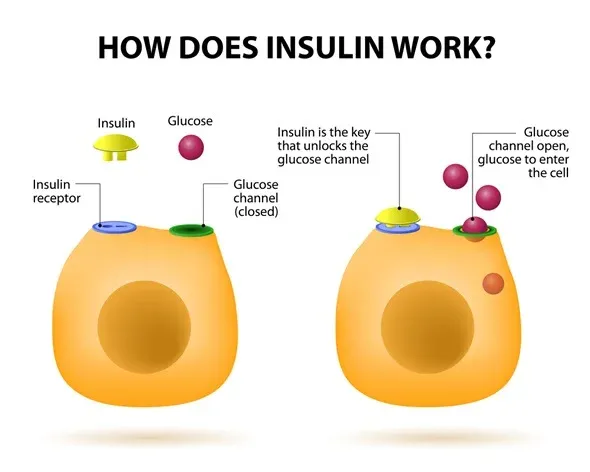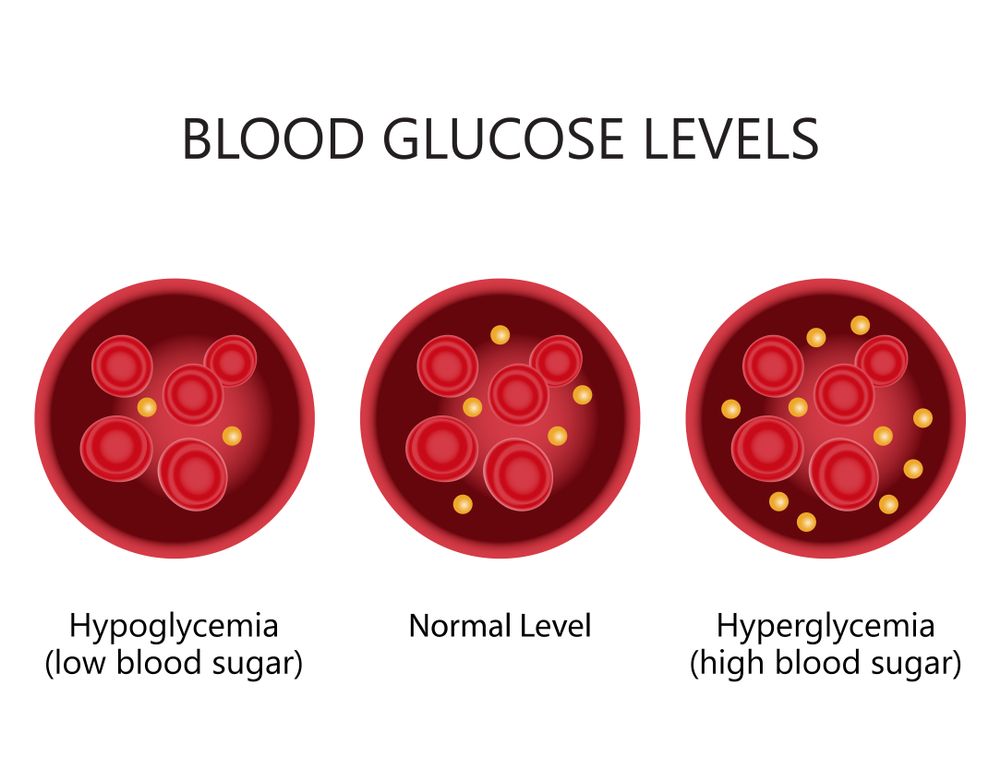Eat Your Way to Better Blood Glucose Control: A Dietitian's Guide

Insulin and blood glucose are two important components in our body that work hand-in-hand to maintain optimal health. Insulin is a hormone produced by the pancreas that helps regulate the amount of glucose (sugar) in our blood. Glucose is the primary source of energy for our body's cells, and it comes from the food we eat. When we eat, our body releases insulin to help move glucose from our bloodstream into our cells where it can be used for energy.
Maintaining proper blood glucose control is crucial in preventing a variety of health problems. High blood glucose levels, also known as hyperglycemia, can lead to complications such as diabetes, heart disease, nerve damage, and kidney damage. On the other hand, low blood glucose levels, or hypoglycemia, can cause symptoms such as shakiness, sweating, confusion, and in severe cases, loss of consciousness.
How insulin works
Insulin helps regulate blood glucose levels by facilitating the uptake of glucose from the bloodstream into the body's cells. When we eat, the glucose level in our blood rises, which triggers the pancreas to release insulin into the bloodstream. Insulin then acts like a key, unlocking the body's cells and allowing glucose to enter, where it can be used for energy or stored for later use.

The pancreas is responsible for producing insulin, and it does so in response to rising blood glucose levels. The pancreas is a gland located behind the stomach, and it contains two types of cells that work together to produce insulin: alpha cells and beta cells. Alpha cells produce glucagon, a hormone that raises blood glucose levels, while beta cells produce insulin.
Insulin sensitivity and insulin resistance are two important concepts related to how insulin works. Insulin sensitivity refers to how responsive our body's cells are to insulin. When our body's cells are sensitive to insulin, it means that they respond well to the insulin produced by the pancreas, and glucose is efficiently taken up from the bloodstream.
On the other hand, insulin resistance occurs when our body's cells become less responsive to insulin. This can happen when we are overweight or obese, inactive, or have other health conditions such as prediabetes or type 2 diabetes. When our body's cells are insulin resistant, it takes more insulin to achieve the same effect of moving glucose from the bloodstream into the cells. This can lead to higher blood glucose levels and eventually, to health problems such as diabetes.
Why blood glucose control is important
Maintaining proper blood glucose control is crucial in preventing a variety of health problems. High blood glucose levels, or hyperglycemia, can lead to a range of health issues, including:
- Diabetes: Prolonged hyperglycemia can cause damage to the blood vessels and organs, leading to complications such as nerve damage, kidney disease, blindness, and amputations.
- Heart disease: High blood glucose levels can increase the risk of developing heart disease by damaging the blood vessels and leading to the buildup of plaque.
- Stroke: Hyperglycemia can also increase the risk of stroke by damaging the blood vessels that supply blood to the brain.
Low blood glucose levels, or hypoglycemia, can also be a problem, especially for people with diabetes who are taking insulin or other blood glucose-lowering medications. Hypoglycemia can cause symptoms such as shakiness, sweating, confusion, and in severe cases, loss of consciousness. Prolonged or frequent episodes of hypoglycemia can also lead to long-term complications, such as cognitive impairment or seizures.
Maintaining good blood glucose control through proper diet, exercise, and medication management is essential in preventing these health problems and living a healthy life.
The science behind blood glucose control

The regulation of blood glucose levels is a complex process that involves several hormones, including insulin, glucagon, cortisol, and others. Insulin is produced by the pancreas in response to rising blood glucose levels and helps to lower blood glucose by promoting glucose uptake and storage in the body's cells. Glucagon, on the other hand, is produced by the pancreas in response to falling blood glucose levels and promotes the release of stored glucose from the liver and other tissues.
The liver plays a critical role in blood glucose regulation by storing glucose as glycogen and releasing it back into the bloodstream as needed. When blood glucose levels are low, the liver breaks down glycogen into glucose in a process called glycogenolysis and releases it into the bloodstream to raise blood glucose levels. When blood glucose levels are high, the liver stores glucose as glycogen in a process called glycogenesis.
Another process that contributes to blood glucose regulation is gluconeogenesis, which is the production of glucose from non-carbohydrate sources such as amino acids and fatty acids. This process occurs mainly in the liver during times of prolonged fasting or low carbohydrate intake.
Overall, the regulation of blood glucose levels is a complex and dynamic process that involves the coordinated actions of several hormones and metabolic pathways in the body. Understanding the science behind blood glucose control can help us make informed choices about our diet, exercise, and medication management to maintain optimal blood glucose levels and prevent health problems.
Ways to maintain good blood glucose control
Maintaining good blood glucose control is essential in preventing health problems associated with high or low blood glucose levels. Here are some ways to achieve and maintain optimal blood glucose control:
- Regular Exercise: Exercise helps to lower blood glucose levels by increasing insulin sensitivity and promoting the uptake of glucose by the body's cells. Aim for at least 150 minutes of moderate-intensity aerobic exercise per week, such as brisk walking, cycling, or swimming.
- Balanced Diet: A balanced diet that is rich in whole grains, fruits, vegetables, lean protein, and healthy fats can help to maintain stable blood glucose levels. Avoid highly processed foods, sugary drinks, and foods that are high in saturated and trans fats. Eating smaller meals more frequently throughout the day can also help to prevent spikes and dips in blood glucose levels.
- Regular Blood Glucose Monitoring: Monitoring blood glucose levels regularly can help to identify patterns and trends and allow for adjustments to diet, exercise, and medication management as needed. People with diabetes should aim to check their blood glucose levels at least several times a day, as directed by their healthcare provider.
- Medication Management: For people with diabetes, taking medications as prescribed by their healthcare provider is essential in maintaining optimal blood glucose control. This may include insulin injections, oral medications, or other blood glucose-lowering medications.
- Stress Management: Stress can contribute to elevated blood glucose levels, so practicing stress-management techniques such as meditation, yoga, or deep breathing exercises can be beneficial.
By implementing these tips and strategies, we can maintain optimal blood glucose control and prevent health problems associated with high or low blood glucose levels.
Here are the 10 best foods for diabetics and the 10 worst foods to avoid:
10 best foods for diabetics:
- Leafy green vegetables such as spinach, kale, and collard greens
- Fatty fish such as salmon, sardines, and mackerel
- Nuts, including almonds, walnuts, and cashews
- Whole grains such as brown rice, quinoa, and oats
- Beans and legumes such as chickpeas, lentils, and black beans
- Berries such as strawberries, raspberries, and blueberries
- Tomatoes
- Citrus fruits such as oranges, grapefruits, and lemons
- Greek yogurt and other low-fat dairy products
- Sweet potatoes
10 worst foods to avoid:
- Sugar-sweetened beverages such as soda, fruit juice, and sweetened tea
- Processed snacks such as chips and crackers
- Candy and other sweets such as cake, cookies, and ice cream
- White bread and other refined carbohydrates
- Fried foods such as fried chicken and french fries
- High-fat red meat such as rib eye and pork ribs
- Full-fat dairy products such as hard cheese and butter
- Alcohol, which can raise blood glucose levels
- Processed meats such as sausage and hot dogs
- Margarine and other trans fats
In conclusion, maintaining good blood glucose control is crucial in preventing health problems associated with high or low blood glucose levels. By understanding the science behind blood glucose control, implementing lifestyle changes such as regular exercise, a balanced diet, and monitoring blood glucose levels regularly, we can achieve and maintain optimal blood glucose control.
It's important to take control of our health and make proactive choices to maintain good blood glucose control. If you're struggling with blood glucose control or have any questions, don't hesitate to reach out to me, for personalized guidance and support. I offer a range of services including nutrition counseling, personalized meal planning, and more. Let's work together to achieve and maintain optimal blood glucose control and overall health and well-being.